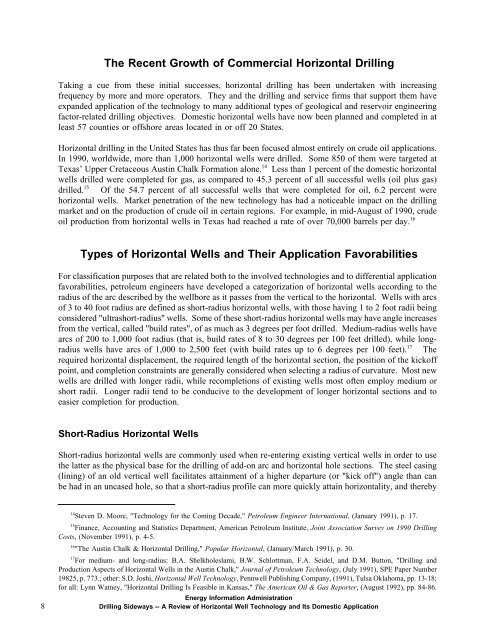Drilling Sideways -- A Review of Horizontal Well Technology ... - EIA
Drilling Sideways -- A Review of Horizontal Well Technology ... - EIA
Drilling Sideways -- A Review of Horizontal Well Technology ... - EIA
You also want an ePaper? Increase the reach of your titles
YUMPU automatically turns print PDFs into web optimized ePapers that Google loves.
The Recent Growth <strong>of</strong> Commercial <strong>Horizontal</strong> <strong>Drilling</strong><br />
Taking a cue from these initial successes, horizontal drilling has been undertaken with increasing<br />
frequency by more and more operators. They and the drilling and service firms that support them have<br />
expanded application <strong>of</strong> the technology to many additional types <strong>of</strong> geological and reservoir engineering<br />
factor-related drilling objectives. Domestic horizontal wells have now been planned and completed in at<br />
least 57 counties or <strong>of</strong>fshore areas located in or <strong>of</strong>f 20 States.<br />
<strong>Horizontal</strong> drilling in the United States has thus far been focused almost entirely on crude oil applications.<br />
In 1990, worldwide, more than 1,000 horizontal wells were drilled. Some 850 <strong>of</strong> them were targeted at<br />
Texas’ Upper Cretaceous Austin Chalk Formation alone. 14 Less than 1 percent <strong>of</strong> the domestic horizontal<br />
wells drilled were completed for gas, as compared to 45.3 percent <strong>of</strong> all successful wells (oil plus gas)<br />
drilled. 15 Of the 54.7 percent <strong>of</strong> all successful wells that were completed for oil, 6.2 percent were<br />
horizontal wells. Market penetration <strong>of</strong> the new technology has had a noticeable impact on the drilling<br />
market and on the production <strong>of</strong> crude oil in certain regions. For example, in mid-August <strong>of</strong> 1990, crude<br />
oil production from horizontal wells in Texas had reached a rate <strong>of</strong> over 70,000 barrels per day. 16<br />
Types <strong>of</strong> <strong>Horizontal</strong> <strong>Well</strong>s and Their Application Favorabilities<br />
For classification purposes that are related both to the involved technologies and to differential application<br />
favorabilities, petroleum engineers have developed a categorization <strong>of</strong> horizontal wells according to the<br />
radius <strong>of</strong> the arc described by the wellbore as it passes from the vertical to the horizontal. <strong>Well</strong>s with arcs<br />
<strong>of</strong> 3 to 40 foot radius are defined as short-radius horizontal wells, with those having 1 to 2 foot radii being<br />
considered "ultrashort-radius" wells. Some <strong>of</strong> these short-radius horizontal wells may have angle increases<br />
from the vertical, called "build rates", <strong>of</strong> as much as 3 degrees per foot drilled. Medium-radius wells have<br />
arcs <strong>of</strong> 200 to 1,000 foot radius (that is, build rates <strong>of</strong> 8 to 30 degrees per 100 feet drilled), while longradius<br />
wells have arcs <strong>of</strong> 1,000 to 2,500 feet (with build rates up to 6 degrees per 100 feet). 17 The<br />
required horizontal displacement, the required length <strong>of</strong> the horizontal section, the position <strong>of</strong> the kick<strong>of</strong>f<br />
point, and completion constraints are generally considered when selecting a radius <strong>of</strong> curvature. Most new<br />
wells are drilled with longer radii, while recompletions <strong>of</strong> existing wells most <strong>of</strong>ten employ medium or<br />
short radii. Longer radii tend to be conducive to the development <strong>of</strong> longer horizontal sections and to<br />
easier completion for production.<br />
Short-Radius <strong>Horizontal</strong> <strong>Well</strong>s<br />
Short-radius horizontal wells are commonly used when re-entering existing vertical wells in order to use<br />
the latter as the physical base for the drilling <strong>of</strong> add-on arc and horizontal hole sections. The steel casing<br />
(lining) <strong>of</strong> an old vertical well facilitates attainment <strong>of</strong> a higher departure (or "kick <strong>of</strong>f") angle than can<br />
be had in an uncased hole, so that a short-radius pr<strong>of</strong>ile can more quickly attain horizontality, and thereby<br />
14 Steven D. Moore, "<strong>Technology</strong> for the Coming Decade," Petroleum Engineer International, (January 1991), p. 17.<br />
15<br />
Finance, Accounting and Statistics Department, American Petroleum Institute, Joint Association Survey on 1990 <strong>Drilling</strong><br />
Costs, (November 1991), p. 4-5.<br />
16 "The Austin Chalk & <strong>Horizontal</strong> <strong>Drilling</strong>," Popular <strong>Horizontal</strong>, (January/March 1991), p. 30.<br />
17 For medium- and long-radius: B.A. Shelkholeslami, B.W. Schlottman, F.A. Seidel, and D.M. Button, "<strong>Drilling</strong> and<br />
Production Aspects <strong>of</strong> <strong>Horizontal</strong> <strong>Well</strong>s in the Austin Chalk," Journal <strong>of</strong> Petroleum <strong>Technology</strong>, (July 1991), SPE Paper Number<br />
19825, p. 773.; other: S.D. Joshi, <strong>Horizontal</strong> <strong>Well</strong> <strong>Technology</strong>, Pennwell Publishing Company, (1991), Tulsa Oklahoma, pp. 13-18;<br />
for all: Lynn Watney, "<strong>Horizontal</strong> <strong>Drilling</strong> Is Feasible in Kansas," The American Oil & Gas Reporter, (August 1992), pp. 84-86.<br />
Energy Information Administration<br />
8 <strong>Drilling</strong> <strong>Sideways</strong> -- A <strong>Review</strong> <strong>of</strong> <strong>Horizontal</strong> <strong>Well</strong> <strong>Technology</strong> and Its Domestic Application

















